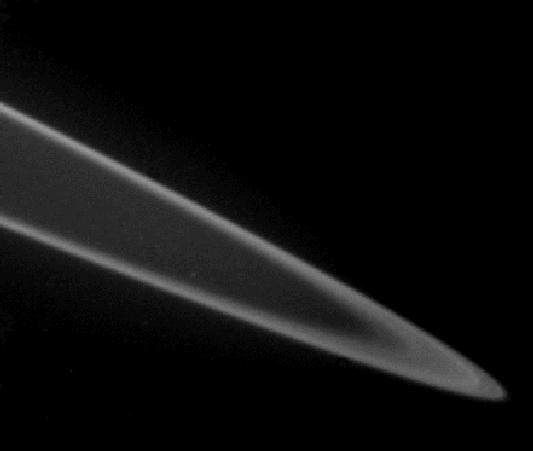
home •
about •
essential guide •
picture of the day •
thunderblogs •
news •
multimedia •
predictions •
products •
get involved •
contact
picture of the day archive subject index
Jupiter’s main ring. Credit: NASA/JPL Galileo Mission
May 05, 2008
Shedding Some Light On Jupiter
Jupiter’s rings were unknown until about thirty years ago. Recent data analysis from the Galileo spacecraft reveals electric currents flowing around the planet, just as EU theorists predicted.A recent announcement by scientists from the Jet Propulsion Laboratory, NASA and the University of Maryland states that Jupiter’s rings are actually electrically charged. Douglas Hamilton, a planetary scientist from the University of Maryland wrote:
"On Jupiter's day side, the sunlight charges the dust particles positively, while on the night side the particles carry a negative charge. Different charges react differently to Jupiter's magnetic field, leading to changes in particle orbits, and when conditions are right, even the tilt or inclinations of the ring particles change.”
Jupiter's rings are formed out of a thin sheet of material encircling the planet. The ring structure is quite diffuse, making observations difficult unless they are in correct alignment with the Sun. The outer radius begins at 129,000 kilometers, almost the same distance as the moon Adrastea. The four small moons, Metis, Adrastea, Amalthea and Thebe, are said to influence the structure of Jupiter’s rings in the same way that the “shepherd moons” of Saturn govern the shape of its huge ring formation.
More than four years ago Picture of the Day articles addressed the "volcanic" plumes on Jupiter's moon Io and demonstrated that they are plasma discharges from the moon to the gas giant. Some planetary scientists later began to acknowledge the electrical connection between them when Io's "footprint" was seen in the polar aurora on Jupiter. In fact, all four of Jupiter’s largest moons were discovered to leave their marks in the aurora in the shape of “tails” flowing within the plasma column. Later, when NASA launched New Horizons on a mission to study Pluto and Charon, the “plumes” of Tvashtar, a gigantic volcano on Io, were found to be filamentary in structure with indications that they are actually corona arc discharges from the electric “hot spots” linking the moon with Jupiter.
Astronomers suggested that “tides” on Io from the “kneading” effect of Jupiter’s gravity cause the charged particles to be released in the "volcanic" plumes. The particles then flow as an electric current to Jupiter. Since electricity does not flow in one direction the one-way connection cannot be correct, so how is the electricity moving between Io and Jupiter?
Conventional theories assume that the universe is electrically neutral, so when observational evidence confirms electrically active plasma for instance, localized phenomena no matter how improbable are invoked. Tidal forces and volcanoes are presented as the cause for the activity seen on Io and the evidence for electric circuits is ignored. In the case of Jupiter’s rings, the same thing is happening. The ring charge is said to be caused by sunlight and shadow rather than by an electrically active circuit between Jupiter and the Sun.
Jupiter is connected with the Sun and the Sun is connected with the Milky Way – and the Milky Way is probably connected with the Local Group and then with the Cluster and so on and so on. That idea is what forms the basis of Electric Universe Theory that all things throughout the cosmos are composed of electrically quasi-neutral conducting plasma - extremely diffuse on the large-scale but capable of transmitting currents powerful enough to energize stars and the galaxies.
An electrical interaction between Jupiter and its moons means that they are charged bodies and are not electrically neutral. Jupiter exists in a dynamic electrical relationship to the Sun and it is now known that charged particles from the Sun and not “electric dynamos" power the planetary aurorae. Just like the aurorae, the ring system on Jupiter is probably behaving in similar fashion to what is seen on Saturn, so a similar explanation is most likely correct.
The gas giant planets all have rings in some form or another. The plasma torus that surrounds each of them and the electric currents flowing along the polar axes and then out the equatorial plane are the likely cause for their persistence. No one knows for sure how planetary ring systems are formed and maintained, but rather than seeking the answer in strictly mechanical action electricity and current flow through dusty plasma will provide more reasonable explanations.
By Stephen Smith___________________________________________________________________________
Please visit our Forum
The Electric Sky and The Electric Universe available now!

|
|

|
EXECUTIVE EDITORS:
David Talbott, Wallace Thornhill
MANAGING EDITORS:
Steve Smith, Mel Acheson
CONTRIBUTING EDITORS: Michael Armstrong, Dwardu Cardona,
Ev Cochrane,
C.J. Ransom, Don Scott, Rens van der Sluijs, Ian Tresman
WEBMASTER: Brian Talbott
Copyright 2008: thunderbolts.info
![]()
home •
thunderblogs •
forum •
picture of the day •
resources •
team •
updates •
contact us

